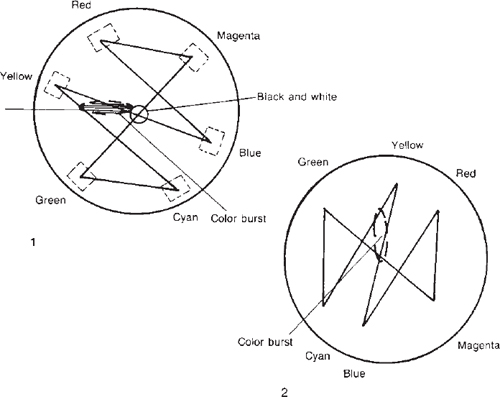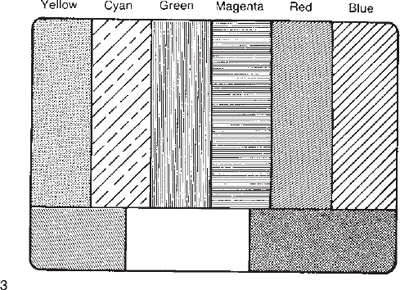The vectorscope enables you to monitor the color signals.
Vectorscopes
While the waveform monitor presents a graphic display of the black and white information in a picture (its luminance), a vectorscope presents a graphic display of the color information in a picture (its chrominance).
Reading the Vectorscope
Production people must know the basics of reading and operating the vectorscope. Like the waveform display, a vectorscope displays signal patterns for scan lines on a CRT. Both the waveform monitor and the vectorscope continuously display 525 lines (one video frame) 30 times every second.
The vector display is round, with both black and white located in the center. The little loop in the signal to the left of center (at the 9 o'clock position) is the color burst. The primary and complementary colors are assigned locations in relation to the color burst. Going in a clockwise direction, yellow is about 10° beyond the color burst, red 76° beyond the color burst, magenta 120° beyond the color burst, blue 190° beyond the color burst, cyan 256° beyond the color burst, and green 300° beyond the color burst. This assignment of information in relation to the color burst determines the color's hue. In the figure at the top you see the typical vector display.
Color Bar Display
Color bars are reference signals produced by the sync generator and placed at the beginning of a tape when it is recorded. If we read the color bar display on the vectorscope, we can adjust the video system for proper color. Probably the only time production personnel will need to use a vectorscope is for adjusting color.
The sequence of colors in the color bar display is identical to the path of the signal displayed on the vectorscope: from center (both white and black) to yellow, cyan, green, magenta, red, blue, and back to center.
Look at the vectorscope diagram. You will notice that each color falls into its own little box on the vectorscope. This indicates that you are seeing the full level of chroma. Take the red bar, for example. If the chroma were cut in half, the trace on the vectorscope for the red color would stop about halfway between the center of the display and the red box. The basic color would still be red, but it would be a paler red.
When playing back a videotape, you'll look first at the display of the color bars and, if necessary, make a few adjustments to get the same pattern as in the first figure. Once the color bars are right, the colors in the video images that follow on the tape should accurately represent the colors in the scene that was originally photographed.
1. Schematic of a vectorscope monitor.
2. Vector display rotated 90 degrees.
3. Color bars.


